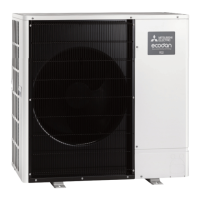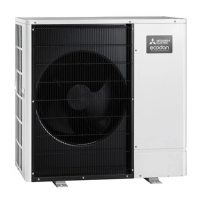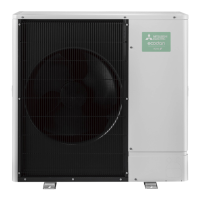
Do you have a question about the Mitsubishi Electric PUZ-SWM AA Series and is the answer not in the manual?
| Brand | Mitsubishi Electric |
|---|---|
| Model | PUZ-SWM AA Series |
| Category | Heat Pump |
| Language | English |
Explains the meaning of various safety symbols used in the manual.
Highlights critical safety warnings for unit installation, protective equipment, and structural integrity.
Details hazards from refrigerant leaks, electrical work, and improper material usage.
Covers safe handling, maintenance, storage, and compliance with regulations for safe operation.
Addresses environmental factors, handling, transport, and electrical work safety for installation.
Emphasizes safety measures for electrical installation, including breakers and grounding.
Outlines essential safety steps before and after initiating a test run.
Details R32 handling, required tools, and associated safety precautions.
Covers comprehensive safety checks and procedures for systems with flammable refrigerants.
Addresses safety during electrical component work, ensuring integrity and preventing ignition.
Details leak detection procedures and safe practices during brazing.
Outlines safe procedures for refrigerant circuit repair and safety requirements for charging.
Covers safe procedures for refrigerant recovery and disposal, including equipment handling.
Specifies pipe limits and guides on selecting an appropriate and safe location for outdoor unit installation.
Displays unit dimensions and details required clearances and ventilation strategies for optimal airflow.
Provides guidelines for calculating minimum installation space based on refrigerant charge and ventilation.
Details foundation requirements, bolt specifications, and secure mounting procedures for the outdoor unit.
Emphasizes secure installation on stable structures to prevent damage and injury.
Outlines crucial precautions for R32 piping, charging, and air handling.
Details connecting pipes, insulation, protection, and flare connection procedures.
Explains leak testing, stop valve opening, and pipe protection/sealing methods.
Details how to charge additional refrigerant based on piping length and other factors, with safety warnings.
Explains the use of drain sockets and pans, with a caution for cold regions.
Displays available ranges for water flow rate and return temperature during heating and cooling.
Illustrates how piping length and diameter affect heating and cooling capacity.
Illustrates wiring connections for the outdoor unit, including single and three-phase configurations.
Details wiring requirements, specifications, and warnings for field electrical connections.
Outlines test run procedures, safety checks, and compressor protection mechanisms.
Describes how to enable low noise and demand functions using DIP switches.
Provides procedures for refrigerant collection and setting system control addresses.
Summarizes the technical specifications, including dimensions and sound levels, for various outdoor unit models.
Informs users about the location and format of the unit's serial number for identification.












